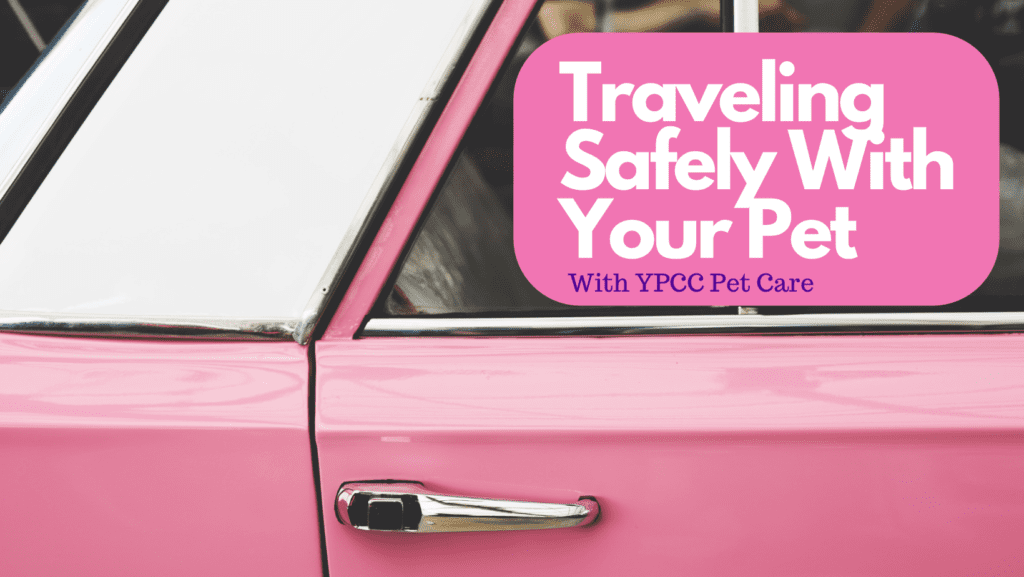
Holiday Pet Travel Safety, For Moore County Pet Owners
The holidays are a wonderful time for travel and celebration, often with pets joining in on the fun! Whether you’re driving to visit family, taking a road trip, or flying to your holiday destination, keeping your pets safe and comfortable is essential for a successful trip. Here’s everything you need to know to ensure a smooth, stress-free holiday journey for the entire family (pets included).
1. Pre-Travel Preparations, For Your Pet
Veterinary Check-Up
Before heading out, schedule a vet visit to ensure your pet is healthy enough to travel. Routine veterinary care is especially important for very young, and geriatric pets. Seeing your vet prior to travel helps in the following ways:
- Keeping your pet up-to-date on their vaccines helps prevent the spread of animal diseases, while simultaneously protecting your pet from contracting anything while you’re traveling.
- A thorough vet check helps ensure that your pet is healthy enough to travel. Underlying health conditions, such as heart disorders, need to be checked prior to any form of air travel.
- Allows your vet to provide you with any necessary medications your pet may need, for a safe & relaxed trip.
Identification and Microchipping
- Collar & Tag: Make sure your pet has a sturdy collar with an ID tag containing your contact information.
- Microchip: If your pet isn’t microchipped, consider having it done before your trip. A microchip provides an added layer of safety in case your pet gets lost. Ensure your pet’s microchip is actively registered. Without proper registration, there will be no information attached to it. Check out this great site, to register your pets microchip for HERE FOR FREE!
Comfortable Carrier or Crate
Choose a sturdy, well-ventilated carrier or crate for safe travel. It should be large enough for your pet to stand, turn around, and lie down comfortably. For extra comfort, line the carrier with their favorite blanket or bedding.
For cats, always ensure that your cat is properly fitted with a harness and leash, inside of their carrier, as a precautionary measure. Be sure that the leash is either removed, or hanging out of the bag to prevent choking. If startled, many cats will choose flight over fight to get away from a stressful situation. Reduce the risk of losing your cat, when removing your cat from their carrier, and keep them safely with you.
Pack a Pet Travel Bag
Just like packing for yourself, prepare a travel bag for your pet. Be sure to include:
- Food and water (along with collapsible bowls)
- Leash and harness
- Waste bags or litter supplies
- Any medications they may need
- Comfort items like toys or blankets
2. Car Travel Safety Tips, For Pets
Secure Your Pet Properly
Pets should always be restrained when in a moving vehicle. Use a pet seatbelt, harness, or secure their carrier with the seatbelt. This keeps your pet safe in case of sudden stops and minimizes distractions for the driver.
Take Breaks
On long trips, plan for breaks every 2-3 hours. Give your pet a chance to stretch, relieve themselves, and drink water. Be sure to use a secure leash and harness during these breaks to prevent any sudden dashes out of the car.
Keep Heads Inside
Although it’s cute to see pets with their heads out the window, it can be dangerous. Flying debris and cold air can cause injuries. Keeping windows closed or only slightly cracked is safer for your pet.
Maintain a Comfortable Temperature
Be mindful of the temperature inside your vehicle. Extreme cold or heat can be dangerous, so adjust your car’s climate control to keep your pet comfortable throughout the journey.
3. Pet Air Travel Safety Tips
Choose Pet-Friendly Airlines
If you’re flying, research pet policies ahead of time. Many airlines allow small pets to travel in the cabin if they’re in a compliant carrier, but larger pets may need to be checked into the cargo area. Make sure you’re familiar with the airline’s specific requirements and pet travel fees.
Book a Direct Flight When Possible
If possible, choose a direct flight to reduce stress on your pet and avoid the complications of layovers. Arrive early at the airport to allow plenty of time for check-in and security screening.
Stay Calm and Comforting
Airports can quickly become overwhelming for pets, due to noise, scents, and crowds. Keep your tone calm, avoid unnecessary stimulation, and offer treats and gentle reassurance to help ease your pet’s anxiety.
4. Tips for Staying at Pet-Friendly Accommodations
Research Pet Policies
Book pet-friendly accommodations in advance, as holiday availability can be limited. Confirm any fees, pet restrictions, and rules regarding areas where pets are allowed within the property. Remember that a pet friendly hotel will also leave behind new cents, from previous pets, for your pet to investigate while you’re there. Be patient with your pet, and allow them to investigate each new scent when they arrive.
Set Up a Safe Space
When you arrive, create a comfortable area where your pet can relax. Place their carrier or bed in a quiet corner, along with familiar items like toys or blankets, to help them feel more at home.
Respect House Rules
Follow the accommodation’s pet policies and always pick up after your pet. Bring waste bags and disposable litter boxes if needed to maintain cleanliness during your stay. This also helps to reduce the spread of diseases, dispersed through fecal matter.
5. Managing Pet Anxiety on the Road
Stick to Routine
Pets thrive on routine, so try to keep their feeding and bathroom schedules as close to normal as possible. Familiarity can help reduce anxiety during travel.
Use Calming Aids if Needed
If your pet is prone to travel anxiety, ask your vet about calming options like pheromone sprays, calming treats, or anti-anxiety medications. Always consult with your vet before using any new products. Pheromone based products, like pet calming collars, are also available over-the-counter at your local pet store.
Provide Distractions
Bring along chew toys, puzzle treats, or their favorite toys to keep them occupied and reduce boredom. A well-engaged pet is more likely to relax and enjoy the journey. But, be sure not to overuse these as your pet will be receiving plenty of stimulation from their journey!
6. Additional Safety Tips for Holiday Gatherings
Monitor Food & Treat Intake
Holiday meals often include ingredients that are toxic to pets, such as chocolate, onions, grapes, and alcohol. Remind friends and family not to share food with your pet, and have pet-safe treats on hand. Refer to this list of common household items and foods that your pet should eschew from, below.
Designate a Quiet Space During Gatherings
If you’re attending or hosting a gathering, make sure your pet has a quiet space to retreat if they feel overwhelmed. This could be a separate room or even their carrier in a secluded area.
Be Cautious with Decorations
Festive decorations, like tinsel, ornaments, and candles, can be hazardous for pets. Keep fragile or potentially harmful decorations out of reach to prevent accidents.
In Conclusion
Holiday travel with your pet can be a memorable experience when you take the time to prepare and plan for their safety and comfort. By following these tips, you can help ensure a smooth and enjoyable trip for both you and your furry friend. Remember, if you’re unable to bring your pet along, reliable pet care options, such as pet sitting services, are a great way to keep your pet safe and happy at home.
At Your Pet Care Connection, we’re here to support you with pet sitting and travel tips for a worry-free holiday season. Safe travels and happy holidays!







